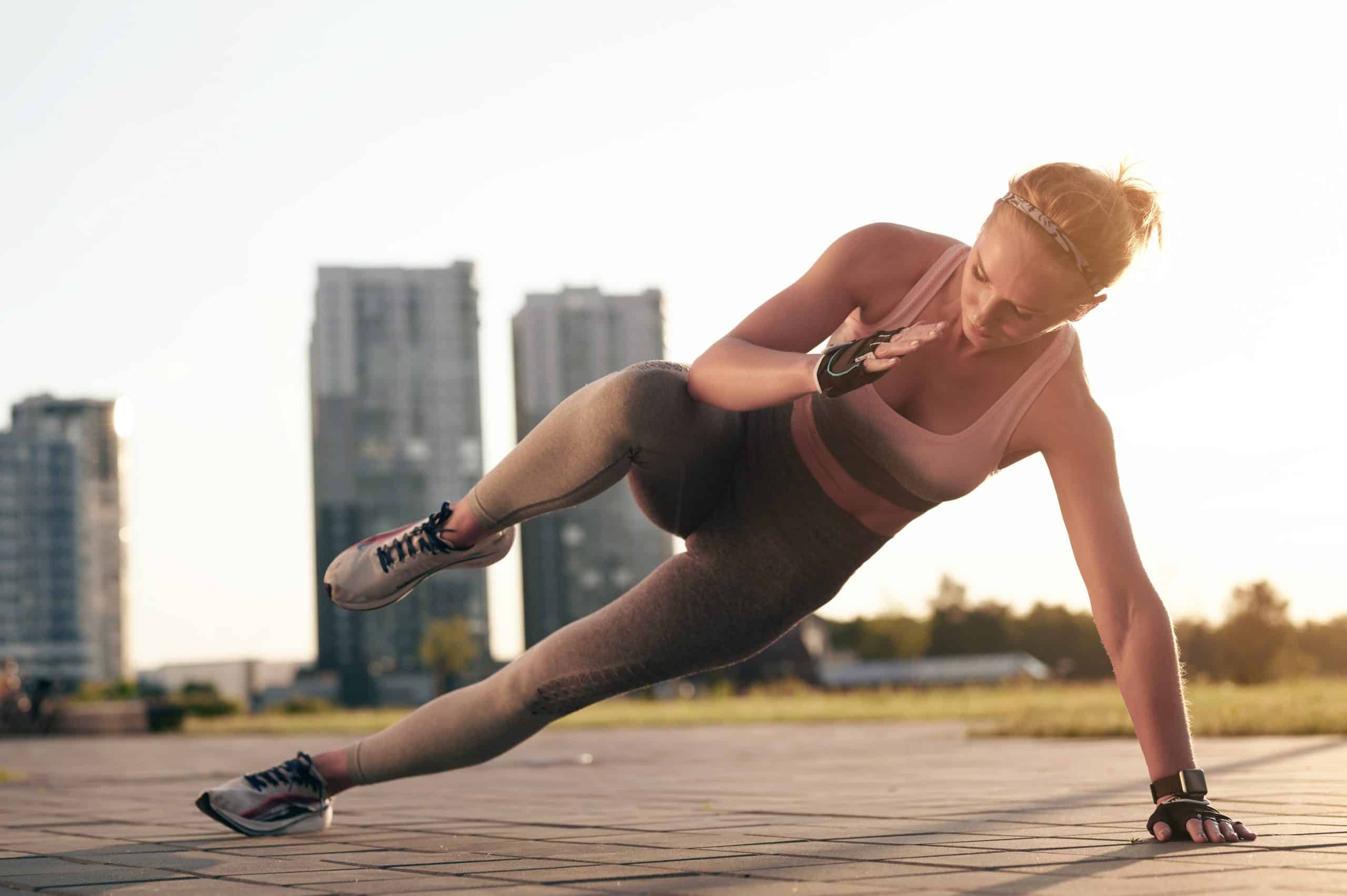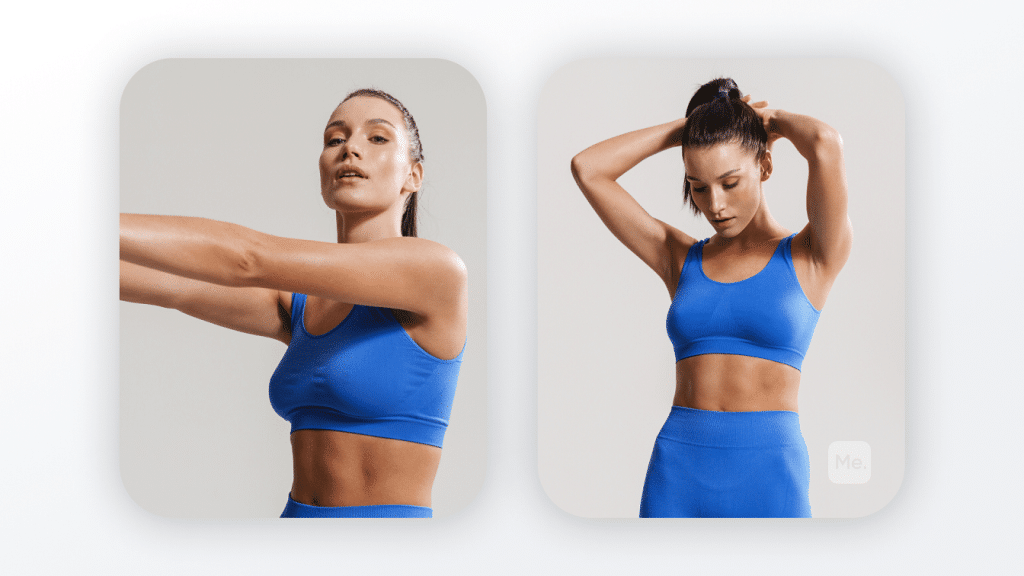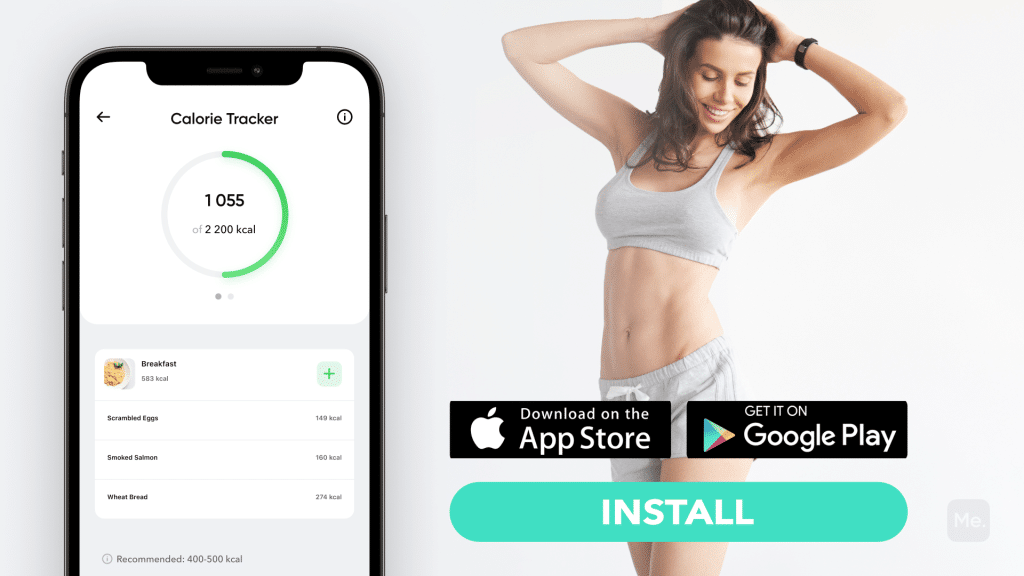Explosive power is the key to success in many sports. From football and basketball, to baseball and hockey, athletes who can generate more power have a clear advantage over their opponents. It’s not only athletes who benefit from explosive power though. Anyone who wants to improve their performance in the gym or in everyday life can benefit from plyometric exercises. And while plyometric training has traditionally been associated with lower-body exercises like jump squats and box jumps, there are actually a number of upper-body plyometric exercises that can help you develop more power and explosiveness. In this guide, we’ll cover everything you need to know about upper-body plyometric exercises, including how to do them, what benefits they offer, and a few key considerations to keep in mind.
Get your personalized
meal plan!
What Are Plyometric Exercises?
Plyometric exercises are a type of high-intensity training that uses quick, powerful movements to build muscle and improve athletic performance. These exercises are often used by athletes to improve their explosive power and speed (3).
Plyometric training is based on the principle of eccentric contractions. Eccentric contractions are when your muscles lengthen as they contract. For example, when you lower yourself into a squat, your quads and glutes eccentrically contract to control your descent.
Plyometric exercises take advantage of this type of contraction by using it to create explosive power. When done correctly, plyometric exercises can help improve your speed, strength, and jumping ability (3).
A common misconception is that plyometrics are all about jumping for the legs only. However, there are actually many types of plyometric exercises that work the arms and upper body as well.
Actually, they work in a similar way to leg exercises, using the eccentric contraction of the muscles to create explosive power. They improve your speed, strength, and power in the same way.
Plyometric exercises are a great way to improve your athletic performance and build muscle. However, they are also very demanding on your body and should be done with caution. Many things can go wrong if you do not follow proper form and technique.
Read More: Plyometric Jumping: Why And How It Works
Who Needs Plyometric Exercises For The Upper Body?
Everyone can benefit from adding plyometric exercises to their workout routine. You don’t need to be an athlete to reap the benefits of these exercises. That said, upper-body plyometric exercises can come in handy for those with the following goals:
De-Loading From Training
A de-load period is a time when you take a break from your normal training routine. This can be for a variety of reasons, such as an injury, burnout, or just to give your body a rest.
During a deload period, it’s important to still keep your body active so you don’t lose any of the progress you’ve made. This is where upper-body plyometric exercises come in.
They provide an effective way to keep your body active and maintain your explosive power without putting too much stress on your joints.
Addressing Muscle Imbalances
Muscle imbalances are very common, especially among athletes. These imbalances can lead to injuries and impair your performance (4).
Upper-body plyometric exercises can help address muscle imbalances by targeting specific muscle groups that may be weak or underdeveloped. This helps to build a more balanced and symmetrical physique (5).
Improving Posture
Poor posture is a common problem that can lead to a variety of health issues, such as back pain and joint problems (1).
Upper-body plyometric exercises can help improve your posture by strengthening the muscles in your upper back and shoulders. This helps to pull your shoulders back and down, improving your overall posture (3).
Improving Functional Strength
Functional strength is the type of strength that allows you to perform everyday tasks with ease. This is different from aesthetic strength, which is the type of strength that helps you lift heavy weights in the gym.
While both types of strength are important, functional strength is more beneficial for most people. That’s because it helps you in your everyday life, whether you’re carrying groceries or chasing after a bus.
Upper-body plyometric exercises can help improve your functional strength by training your muscles to work together in a coordinated way. This helps to improve your balance, coordination, and stability, making everyday tasks easier (2).
Breaking Monotony In Your Workout Routine
If you’re someone who gets bored easily, then you know how important it is to mix things up in your workout routine. Otherwise, you’ll quickly lose motivation and stop seeing results.
Upper-body plyometric exercises can help break the monotony of your workout routine by adding a new and challenging element. This can help to reignite your passion for working out and help you stick with it in the long run.
If you wish to cinch your waist, tone up your bat wings, blast away the muffin top – our fitness app was created to cater to all your needs! BetterMe won’t give excess weight a chance!
Upper Body Plyometric Exercises For Beginners
Beginners focus on developing proper form and technique before adding any weight. This helps to prevent injuries and ensures you’re getting the most out of the exercises. They prepare their bodies for the more demanding exercises that come later.
Kneeling for these exercises recruits more stabilizer muscles than being in the standing position. It specifically calls on core muscles to power the movement. Core engagement also helps with balance, an important ingredient in all plyometric exercises.
Kneeling Overhead Throw
The overhead throw engages the shoulders, triceps, and core. It also helps develop rotational power in the hips and trunk.
How to execute the exercise:
- Assume a kneeling position with your back straight, feet hip-width apart, and knees bent at 90 degrees.
- Hold a medicine ball with both hands overhead.
- Keeping your core engaged, slam the ball in front of you as hard as you can.
- Catch the ball and repeat.
Kneeling Chest Pass
The chest pass recruits the muscles in the chest, shoulders, and triceps. It also helps develop power in the hips and trunk.
How to execute the exercise:
- Assume a kneeling position with your back straight, feet hip-width apart, and knees bent at 90 degrees.
- Hold a medicine ball at chest level with both hands.
- Keeping your core engaged, explosively throw the ball straight ahead.
- Catch the ball and repeat.
Half-Kneeling Lateral Throw
The half-kneeling lateral throw engages the muscles in the shoulders, obliques, and core. It also helps develop power in the hips.
How to execute the exercise:
- Next to a wall, in a sideways position assume a half-kneeling stance with your back straight, feet hip-width apart.
- One knee should be bent at 90 degrees and placed on the ground. The other leg should be positioned in front of you with the knee bent at 90 degrees.
- Hold a medicine ball at chest level with both hands.
- Keeping your core engaged, rotate your torso slightly away from the wall then turn and explosively throw the ball laterally against the wall.
- As soon as the ball hits the wall, catch it and repeat. Be sure to catch the ball with both hands. Perform the specified number of reps then switch sides and repeat.
Battle Rope Waves
The battle rope wave is a great exercise for the shoulders, arms, and core. It involves the use of large muscles and can be performed at a high intensity, making it great for burning calories.
How to execute the exercise:
- Stand with your feet hip-width apart and hold an end of the rope in each hand.
- Keeping your core engaged, raise your arms so that they’re parallel to the ground.
- From here, rapidly move your arms up and down, creating waves in the rope.
- Continue for the specified amount of time.
Read More: Plyometric Exercises For Speed: 7 Moves To Help You Run Faster
Kneeling Plyometric Push-Up
The push-up is a great exercise for the chest, shoulders, and triceps. Adding the plyometric element increases the intensity and makes it an arm and core exercise.
How to execute the exercise:
- Kneel on the ground and place your hands on the ground, slightly wider than shoulder-width apart.
- Keeping your core engaged, lower your body until your chest nearly touches the ground then explosively push-up, propelling your hands off the ground.
- As you reach the top of the push-up, clap your hands together before placing them back on the ground.
- Lower your body back to the starting position and repeat.
Upper Body Plyometric Exercises For Intermediates
After mastering the beginner exercises, you can move on to more challenging exercises that will help you build even more power. These exercises are a bit more advanced and should only be done when you notice advancements in your strength and power.
Standing Overhead Slam
The overhead slam is a great exercise for the shoulders, triceps, and core. It also helps develop power in the hips and trunk. When performed standing, it’s more challenging and puts more emphasis on strength and stability.
How to execute the exercise:
- Stand with your feet hip-width apart and hold a medicine ball with both hands overhead.
- Keeping your core engaged, slam the ball in front of you as hard as you can.
- Catch the ball and repeat.
Depth Push-Ups
Depth push-ups are a great exercise for the chest, shoulders, and triceps. They’re more challenging than regular push-ups and help develop explosive power.
How to execute the exercise:
- Set up two elevated surfaces that are roughly shoulder-width apart. These can be small boxes, dumbbells, or weight plates.
- Place your hands on the elevated surfaces and lower your body until your chest nearly touches the ground.
- Keeping your core engaged, explosively push-up, propelling your hands off the ground.
- As you reach the top of the push-up, clap your hands together before placing them back on the surfaces.
- Lower your body back to the starting position and repeat
- Make sure to land with bent elbows to help absorb the impact.
Plyometric Pull-Ups
Plyometric pull-ups are a great exercise for the back, biceps, and core. They help develop explosive power in the muscles used for pulling.
How to execute the exercise:
- Grab a pull-up bar with an overhand, shoulder-width grip.
- Hang from the bar with your legs crossed behind you.
- Keeping your core engaged, explosively pull yourself up until your chin is over the bar.
- Lower yourself back to the starting position and repeat.
You can also perform this exercise with an underhand grip or with one hand.
Sit-Up And Pass
The sit-up and pass is a great exercise for the abs and core. It must be done in pairs as you pass the ball to each other.
How to execute the exercise:
- Sit on the ground facing each other with your knees bent and feet on the ground. Your trunk should be at a 45-degree angle to the ground.
- Hold a medicine ball with both hands and pass it to your partner.
- As you catch the ball, quickly sit up and pass the ball back to your partner.
- Lie back down and repeat.
- Keep your core engaged throughout the exercise.
BetterMe is your fast-track ticket to a long-lasting weight loss! Tailor your fitness journey and maximize your results with just a couple of swipes!
Upper Body Plyometric Exercises For Advanced
Those who’ve been performing plyometric exercises for a while and have developed a good amount of power and strength can move on to these advanced exercises. They’re more challenging and put more emphasis on dynamic movement and coordination.
There will be a greater load on the muscles and joints, so make sure to warm up properly before attempting these exercises.
Feet Elevated Plyo Push-Ups
The feet elevated plyo push-up is a great exercise for the chest, shoulders, and triceps. Elevating the feet increases the range of motion and makes the exercise more challenging.
How to execute the exercise:
- Place your feet on an elevated surface and your hands on the ground.
- Lower your body until your chest nearly touches the ground.
- Keeping your core engaged, explosively push-up, propelling your upper body off the ground.
- As you reach the top of the push-up, remove your hands from the ground and clap them together before placing them back on the ground.
- Land with bent elbows to help absorb the impact and repeat.
Double Clap Push Ups
When you’ve established great upper body strength through plyometric exercises, you can move on to the double clap push up. This is a more challenging exercise that requires coordination and explosive power.
How to execute the exercise:
- Start in a push-up position with your hands on the ground and your feet together.
- Keeping your core engaged, explosively push-up, propelling your upper body and hands off the ground.
- As you reach the top of the push-up, clap your hands together twice before placing them back on the ground.
- Land with bent elbows to help absorb the impact and repeat.
Overhead Throw With Step
The overhead throw with step is the most advanced of all overthrow variations as it requires coordination and explosive power in the upper and lower body. This exercise is great for the shoulders, chest, abs, and legs.
How to execute the exercise:
- Start by holding a medicine ball with both hands at chest level.
- Keeping your core engaged, take a step while simultaneously throwing the ball overhead.
- Step back as the ball comes down and catch it with both hands.
- Repeat the movement, throwing the ball overhead as you take a step with the opposite leg.
- For an extra challenge, try to throw the ball higher with each repetition.
The Bottom Line
Upper body plyometric exercises are a great way to develop explosive power and strength. They’re also great for building coordination and improving dynamic movement.
If you’re new to plyometric exercises, start with the basic exercises and progress to the more advanced exercises as you get stronger. Remember to warm-up properly before attempting any of these exercises.
DISCLAIMER:
This article is intended for general informational purposes only and does not serve to address individual circumstances. It is not a substitute for professional advice or help and should not be relied on for making any kind of decision-making. Any action taken as a direct or indirect result of the information in this article is entirely at your own risk and is your sole responsibility.
BetterMe, its content staff, and its medical advisors accept no responsibility for inaccuracies, errors, misstatements, inconsistencies, or omissions and specifically disclaim any liability, loss or risk, personal, professional or otherwise, which may be incurred as a consequence, directly or indirectly, of the use and/or application of any content.
You should always seek the advice of your physician or other qualified health provider with any questions you may have regarding a medical condition or your specific situation. Never disregard professional medical advice or delay seeking it because of BetterMe content. If you suspect or think you may have a medical emergency, call your doctor.
SOURCES:
- 3 surprising risks of poor posture (2021, harvard.edu)
- CURRENT CONCEPTS OF PLYOMETRIC EXERCISE (2015, nih.gov)
- Effects of Plyometric Training on Physical Fitness in Team Sport Athletes: A Systematic Review (2016, nih.gov)
- Occurrence of Muscle Imbalance and Risk of Injuries in Athletes using Overhead Movements: A Systematic Review (2021, researchgate.net)
- Plyometric Training Improves Sprinting, Jumping and Throwing Capacities of High Level Female Volleyball Players Better Than Skill-Based Conditioning (2017, nih.gov)















